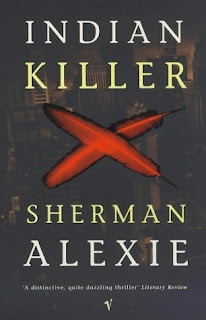Pan-Indian Landscapes in Alexie’s Reservation Blues
Alexie’s representations of place have also attracted criticism. While Reservation Blues (1996) and his earliest short stories are primarily located on the Spokane Indian Reservation and are littered with authentic place names (Wellpenit, Spokane Falls, Riverfront Park, Reardon), Alexie provides few visual references to landscape which would anchor these stories to a specific geographical location. Owens describes the reservation portrayed by Alexie as being ‘a vaguely defined place where people live in cheap federal housing while drinking, playing basketball, feuding with one another, and dying self-destructive and often violent deaths’ (1998:71-2). Bernardin takes up this point and suggests that Alexie deliberately uses what she refers to as ‘generic signifiers of “Indianness”’ (2004:167) to build a physical world recognisable by his target audience – young Native Americans[i]. The reservation Alexie describes could be anywhere in the country, and just as there are few visual clues to identify the location of his stories, there is little to distinguish Alexie’s Spokane Indians from members of any other Native American tribe.
Fellow Spokane , the writer and academic Gloria Bird regards Reservation Blues as a ‘partial portrait of a community wherein there is no evidence of Spokane culture or traditions, or anything uniquely Spokane Spokane culture ‘misconstrue what is Indian, or specifically Spokane
Bernardin suggests that Alexie has deliberately created a generic reservation backdrop with culturally generic Indian characters in order to garner a ‘pan-Indian readership’ (2004:167). Indeed, Alexie often seems keen to build an alliance between diverse Native tribes, emphasising their commonality as a brutalised people. In Reservation Blues, the Spokane
We were both at Wounded Knee when the Ghost Dancers were slaughtered. We were slaughtered at Wounded Knee . I know there were whole different tribes there, no Spokanes or Flatheads, but we were still somehow there. There was a part of every Indian bleeding in the snow. All those soldiers killed us in the name of God, enit? They shouted “Jesus Christ” as they ran swords through our bellies. Can you feel the pain still, late at night, when you’re trying to sleep, when you’re praying to a God whose name was used to justify the slaughter? (Alexie 1996:167)
Through the use of non-specific representations of landscape and Indian culture, Alexie unites Native Americans in a single grieving consciousness.
While details of the physical location are scarce, the historical aspects included in the wider definition of landscape serve to create a real and realistic space within the novel. In the opening scene, the legendary blues guitarist Robert Johnson arrives at the town of Wellpinit
The town of Wellpinit
Described as being ‘the only town on the reservation’ (ibid:3), Wellpinit is seen to be isolated, and its absence from maps creates an illusory impression which is reinforced by references to mythological beings, and by the figures of Big Mom and Robert Johnson – a man purported to have been murdered in Mississippi decades before. In contrast to Owens’ depictions of the forest as the natural home of the Stehemish people, Alexie offers a perception of the woodlands around Wellpinit very similar to perceptions found in many European folktales, where the forest is viewed with suspicion as home to witches, goblins and malevolent spirits.
The sense that Wellpinit is indeed a haunted place is furthered by Thomas, who:
thought about all the dreams that were murdered here, and the bones buried quickly just inches below the surface, all waiting to break through the foundations of those government houses built
by the Department of Housing and Urban Development. (ibid:7)
Wellpinit is haunted by its history, and one of the motifs which runs throughout Reservation Blues regards the historical slaughter of a herd of Spokane
As she stepped out of her front door, Big Mom heard the first gunshot, which reverberated in her DNA. She pulled her dress up around her waist and ran for the clearing, heard a gunshot with each of her footfalls....
Big Mom ran to the rise above the clearing where the horses gathered. There, she saw the future and the past, the white soldiers in blue uniforms with black rifles and pistols. She saw the Indian horses shot and fallen like tattered sheets. (ibid:9-10)
This episode is clearly a defining moment in Spokane Veterans Hospital
In the early part of his career, the period to which Reservation Blues belongs, Alexie strove to reach a Pan-Indian audience, and to this effect he recreated the Spokane Indian Reservation with a deliberately amorphous appearance. By focusing, primarily, on those physical details of place which are immediately recognisable to Native Americans on reservations across the United States Spokane
[i] In an interview with John Purdy (1997), Alexie is dismissive of the work of Gerald Vizenor, known for his elevated narrative style saying, ‘If Indian literature can’t be read by the average twelve-year-old kid living on the reservation, what the hell good is it?’
[ii] Bird’s criticism could also be levelled at Owens whose mixedblood Flathead character McBride uses the word ‘Yatahey’, a variation of the Navajo greeting ‘Ya’at’eeh’, and who also uses the term ‘sweatlodge’ (Owens 1992:181, 189).
[iii] Stick Indians appear in the oral tradition of many tribes in the Pacific Northwest, including the Spokane




Comments